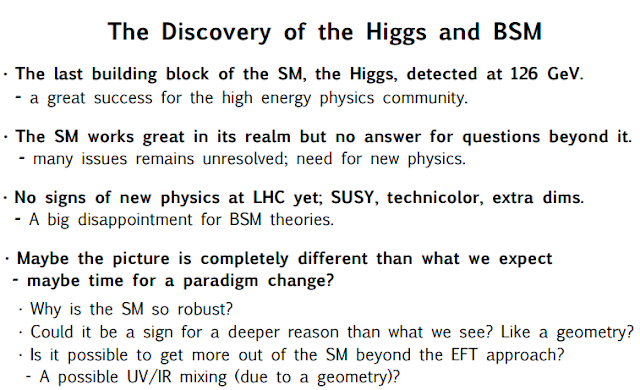Testing if the Higgs mechanism is a natural part of (the) quantum gravit(ational geometrization of ph)y(sics) at LHC 2?
The unnatural effectiveness of the standard model for particle physics phenomenology
The periphysicist / blogger pursues his quest for beyond standard model physics staying tuned to the music of spheres. Excited like all science enthusiasts by the starting of LHC Season 2 he's focusing today on one of the still few particle phenomenological works (already reported in a former post) that could offer hope for a testable bottom-up approach to the spectral noncommutative geometrization of physics at LHC . Let's start with the first slide of a parallel talk at 20th International Symposium on Particles, Strings and Cosmology, presented by Ufuk AYDEMIR:
Questioning our intuition of naturalness based on local effective field theory
We carry on with two excerpts from the last published article dealing with the same issue as above:
... [the] apparent theoretical appeal of supersymmetry does not exclude approaches that do not necessarily follow the local effective field theory (EFT) paradigm. For example, in the Spectral Standard Model (SM) approach of Connes et al. [29, 57–64] the hierarchy problem can be addressed in a completely different fashion [62]. The crucial noncommutative geometry (NCG) (and thus in some sense non-local) aspect of the SM is found in the Higgs sector, which in principle comes with an extra (second) scale, to be distinguished from the usual UV scale of local EFT. The hierarchy between the Higgs and the UV (Planck) scale can be associated (as shown by Chamseddine and Connes in Ref. [62]) with the natural exponential factor that comes from the dynamical discrete geometry of the Higgs sector. Similarly, the apparent gauge unification (in the guise of an effective SO(10) relation between the gauge couplings) is also incorporated into the Spectral SM.
(last revised 5 Mar 2015 (this version, v3))
Can particle physics phenomenology dates the spectral standard model?
These aspects of the NCG approach to the SM are almost completely unknown in the particle physics community, and at the moment, almost completely undeveloped from a phenomenological viewpoint. One of our aims in our upcoming review of the Spectral SM [71] is to clarify these interesting features of the NCG approach to the SM and make them palatable to the wider phenomenological community. We are also motivated by a deeper need to understand the limitations of the local EFT paradigm from the point of view of the physics of quantum gravity, which is usually, rather naively, ignored at the currently interesting particle physics scales, by invoking the concept of decoupling, which represents another central feature of the local EFT and which is also challenged by the NCG approach to the SM. Finally, as we discuss in the next concluding subsection of this paper, the usual RG analysis of the local EFT should be re-examined in the new light of the non-commutative/non-local structure of the SM, and the apparent existence of two natural (and naturally related) physics scales.
Id.
Does the superconnection formalism cry for noncommutative geometry?
This is basically the question answered in the following slides from one of the authors of the text that has been quoted before:
Parallel talk at the 2015 Phenomenology SymposiumChen SUN, 4/5/2015
Rendez-vous at a 4 TeV Left-Right symmetry breaking scale ?
This seems the basic prediction of the superconnection formalism worked out by the authors of the study exposed here as indicated in the last slide of the first talk this post has started with:
The hidden geometry of the Standard Model from superconnections and TeV scale left-right symmetric model as new physics, Ufuk AYDEMIR 24 Jun 2014
NON-COMMUTATIVE GEOMETRY & THE STANDARD MODEL
\\Last edit on 31 May 2015
Of course this prediction about a possible 4TeV left-right symmetric model with a discrete extra dimension in the spectral noncomutative's way has to be taken with a pinch of salt. We end this post reviewing some pros and cons following another coworker Tatsu Takeuchi:
NON-COMMUTATIVE GEOMETRY & THE STANDARD MODEL
Tatsu Takeuchi Virginia Tech March 26, 2014















Comments
Post a Comment
Cher-ère lecteur-trice, le blogueur espère que ce billet vous a sinon interessé-e du moins interpellé-e donc, si le coeur vous en dit, osez partager avec les autres internautes comme moi vos commentaires éclairés !
Dear reader, the blogger hopes you have been interested by his post or have noticed something (ir)relevant, then if you are in the mood, do not hesitate to share with other internauts like me your enlightened opinion !